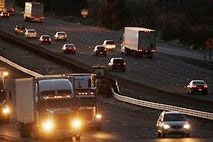US sets new standards for truck, bus emissions
"This comprehensive national program is projected to reduce greenhouse gas emissions by
 |
| AFP/Getty Images/File – Trucks and cars travel the 10 freeway near Banning, California. |
about 250 million metric tonnes and save 500 million barrels of oil over the lives of the vehicles produced within the program’s first five years," the Environmental Protection Agency (EPA) said in a statement.
The program will also have a positive impact on businesses and consumers, as it drives down the cost of transporting freight, said Transportation Secretary Ray LaHood, whose agency was also involved in the new standards.
"This is a win-win-win for the environment, businesses and the American consumer," he said.
The two government agencies expect the innovative technologies fostered by the new rules to yield not just environmental benefits, but also to "enhance energy security" by reducing dependence on foreign oil.
Among the new technologies that can be used to meet the new standards are aerodynamic improvements to the vehicle, and engine and transmission upgrades.
Previous emissions and fuel efficiency standards applied only to light trucks and cars.
The new standards call for manufacturers to make engines and vehicles that achieve up to a 20 percent reduction in carbon dioxide emissions by the time 2014 models come out and an equivalent reduction in fuel consumption by 2018 for larger trucks.
For heavy pick-up trucks and vans, the targets are a 10-percent reduction for gasoline vehicles and 15 percent reduction for diesel vehicles by model-year 2018, while for buses, the target is up to a 10-percent reduction in fuel consumption and CO2 emissions by 2018.
Environmental groups hailed the announcement of the new standards, which will be open for a 60-day comment period starting when the proposal has been published in the Federal Register.
The Sierra Club, the oldest and largest US grassroots environmental organization, noted that heavy goods and passenger vehicles covered by the new standards consume 20 percent of all road transportation fuel used each year but represent just four percent of all vehicles on the road.
"Setting strong fuel efficiency and pollution standards for these vehicles will help break our dirty addiction to oil, increase our national security, reduce pollution, and save truckers and businesses money at the pump," the Sierra Club said.
The BlueGreen Alliance, a partnership between labor unions and environmental organizations aimed at creating quality green jobs, said the standards would help "reduce our dependence on oil, strengthen the American auto and truck manufacturing sectors, create quality jobs and reduce pollution."
And Luke Tonachel, clean vehicles expert at the Natural Resources Defense Council, said the proposed rules would help change the image of heavy trucks and buses, which are currently the "energy hogs of America’s roadways."
"With more efficient engines, aerodynamic bodies and cleaner fuels, our nation’s truck fleets can run cleaner and cheaper. These new standards will save truck owners and consumers money, while creating jobs and reducing pollution in the process," he said.
What the stars mean:
★ Poor ★ ★ Promising ★★★ Good ★★★★ Very good ★★★★★ Exceptional
Related Contents
Latest News
More News
- Global partnerships key to Vietnam’s IFC development (December 26, 2025 | 16:18)
- Vingroup pulls out of bid to invest in North-South high-speed railway (December 26, 2025 | 11:42)
- Strengthening supply chains through trade promotions and customs reform (December 24, 2025 | 14:00)
- PM orders investment model for North–South high-speed rail (December 22, 2025 | 17:43)
- LS Eco Energy to invest in Vietnam rare earth sector (December 22, 2025 | 17:31)
- Government moves to establish International Financial Centre (December 21, 2025 | 21:00)
- Vietnam's IFC to target global investment flows (December 21, 2025 | 18:00)
- Two national hospitals expand capacity with new facilities (December 20, 2025 | 09:00)
- Ha Tinh breaks ground on major Vingroup industrial and energy projects (December 19, 2025 | 18:24)
- EVN launches major power infrastructure projects nationwide (December 19, 2025 | 18:17)

 Tag:
Tag:





















 Mobile Version
Mobile Version